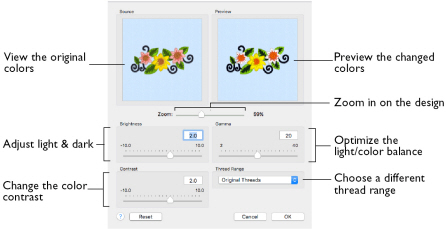The Color Tone ![]() page includes the Brightness, Contrast and Gamma sliders, and the Thread Range box.
page includes the Brightness, Contrast and Gamma sliders, and the Thread Range box.
Note: Try different settings to enhance different designs. You can combine more than one Color Tone tool.
In the Thread Range box, convert all the threads in an embroidery to a new thread range, with or without adjusting the Color Tone options.

To use Color Tone
-
Select the embroidery, then in the Design window click Color Tone
 .
. -
Select the embroidery, then choose Design > Color Tone.
Brightness
The Brightness effect makes the selected part or all of an embroidery lighter or darker than the original. Use it to lighten or darken embroideries.
-
Drag the Brightness slider from -10 to +10. The default setting is 0.
Contrast
The Contrast effect changes the amount of shading between areas for the embroidery. Use it to make specific areas stand out. Adjust Contrast up to +10 or -10 more or less than the original. Increasing the setting will increase the darkness of dark areas and the lightness of light areas.
-
Drag the Contrast slider from -10 to +10. The default setting is 0.
Gamma
Use Gamma to adjust the brightness and contrast together so that dark areas are made brighter, but bright areas are not overexposed. Lower values make the embroidery appear lighter.
-
Drag the Gamma slider from 2 to 40. The default setting is 10.
Thread Range
Use the Thread Range box to select the thread range used for the embroidery from the pop-up menu. Choose from any of the manufacturer’s thread ranges or one of the MyThreads ranges you create using mySewnet™ Thread Cache.
Note: If the embroidery originally used more than one thread range, only one thread range will now be used.
To return to the original thread range(s) used in the design select ’Original Threads’ from the top of the list.
Reset
Reset the embroidery back to the original settings.
Use Color Tone to Change the Colors in a Floral Embroidery
-
Choose File > Insert.
-
Browse to mySewnet/Samples/Embroidery/Stitch.
-
Scroll down to load "Floral Motif.vp4".
-
Open the Design window

of the Control Panel

.
-
Click the first thread in the color worksheet. The thread name and thread range is displayed in the Color Selection dialog. The Thread Range is Robison-Anton Rayon 40.
-
Click OK to close the dialog.
-
Click the Color Tone button

in the Design window. The Color Tone dialog appears.
-
Choose Robison-Anton Poly Neon 40 in the Thread Range pop-up menu. The colors are much brighter.
-
Choose Sulky Rayon 40 in the Thread Range pop-up menu. The change is more subtle.
-
Scroll up the Thread Range pop-up menu and choose Original Threads.
-
Drag the Brightness slider to the right to change the brightness to 2. The thread colors become paler.
Alternatively, enter a positive number in the box. -
In the Contrast number box, enter 2.0 to change the contrast.
-
Click to the right of the Gamma slider to change the Gamma to 20.
-
Click OK to close the Color Tone dialog. The threads in the color worksheet change to their new color and range.
Note: The threads in the design are mapped to the nearest color in the range, and the result shown in the preview.
Note: You can use Reset to reverse all changes made to the design.
The threads return to the original thread range(s) used in the design.
Note: To adjust the Brightness between -10 and +10 relative to the starting point, enter a number in the box, drag the slider, or click to one side of the slider. To darken the embroidery, drag the slider to the left, click to the left, or enter a negative number.
Note: To adjust the Contrast between -10 and +10 relative to the starting point, enter a number, drag the slider, or click to one side of the slider.
Note: To adjust the Gamma between 2 and 40, enter a number, drag the slider, or click to one side of the slider.
Zoom
Use the Zoom functions to change the view of the embroidery. Zoom in (drag the slider to the right) to magnify the view. Zoom out (drag the slider to the left) to shrink the view.
When zoomed in, use the scroll bars or swipe to move around.